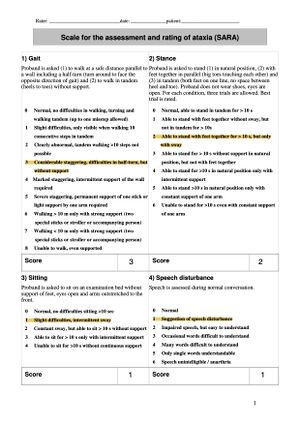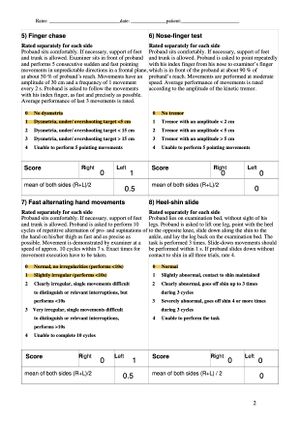Cerebellar Ataxia - A Case Study
Abstract[edit | edit source]
Introduction[edit | edit source]
Cerebellar ataxia is a condition that can have a multitude of different causes and result in a wide variety of symptoms. Ashizara and Xia (2016) defined ataxia as “impaired coordination of voluntary muscle movement” and explain that it is primarily the result of cerebellar damage. As a result of the cerebellum’s divisions and functional segregation, lesions in different areas can have different physical manifestations [1]. Common symptoms of cerebellar ataxia include delays in movement initiation, dysmetria, dyskinesia, dysdiadochokinea, tremor, and disturbances in motor learning[2].
An important issue to address when treating cerebellar ataxia is a potential deficit in motor learning. On account of the cerebellum’s role in motor learning and shifting tasks from attentionally demanding to automatic, it can be challenging to relearn motor sequences necessary for activities of daily living (ADLs) and sustain functional gains from session to session[3].
The following case study describes Sam Brown, a 30-year-old man who suffered cerebellar damage following a motor vehicle accident. In the case of Mr. Brown, the damage primarily affected the midline cerebellar structures. This region is needed for balance, posture, and gait, though cerebellar injuries are seldom isolated to only one region, and Mr. Brown also experienced some motor coordination deficits more typical of lateral cerebellar lesions[2]. A case study by Chester & Reznick (1987) discusses cerebellar ataxia symptoms following severe head trauma. In their research they note that the patient had both midline and lateral cerebellar symptoms. They also discuss an ambiguity behind the anatomical cause of the patient’s cerebellar ataxia – suggesting that it could be the result of diffuse axonal injury following his traumatic brain injury, and that it may have affected multiple brain regions, particularly the superior cerebellar peduncle[4].
The goal of this case study is to paint a picture of a patient suffering from cerebellar ataxia. Ataxia is widely regarded as a physical finding and not a disease[1] and research and case studies of patients suffering from cerebellar ataxia are not abundant, for this reason it is important and interesting to explore a patient case for the specific condition.
Client Characteristics[edit | edit source]
The patient is Sam Brown, a 30-year-old retail manager, working at Staples in Kingston, Ontario. At work he has a variety of tasks including manual labour, customer relations and paperwork. Sam lives with his wife and 6-year-old son in a 3rd floor apartment (20 stairs, has an elevator). Prior to his accident Sam was able to do all activities of daily living and ambulate completely independently. Sam’s hobbies include playing in a hockey league on Saturdays and hiking with his family. Overall, Sam is healthy and active, with no co-morbidities. He is a non-smoker and social drinker (1-2 drinks/week)
On his drive to work 18 days prior, He suffered a motor vehicle accident. In the crash he suffered from a severe concussion, whiplash and a fractured left radius. He was taken to hospital via ambulance and stayed for 5 days to be monitored and begin his rehabilitation process. While in hospital, he worked with Dr. Nancy, a neurologist who noticed Sam’s poor balance and postural control and had an MRI scan completed with him that revealed a midline/left cerebellar hemisphere lesion)[5]. Dr. Nancy diagnosed Sam with Truncal Cerebellar Ataxia and referred him to physiotherapy to help with his motor control symptoms.
After 5 days in hospital, Sam was discharged and referred to outpatient physiotherapy. He is not arriving at physiotherapy day 18 post-accident (day 13 post discharge) to be assessed and have a treatment plan developed.
Examination Findings[edit | edit source]
Clinical Impression[edit | edit source]
Intervention[edit | edit source]
Short Term Goals
- Patient will improve his BBS from 18/56 in 3 weeks by completing the balance exercises in the clinic with supervision and home exercise program
- Patient will improve left leg strength to 4/5 in all joint movements in 3 weeks by completing strength exercises and walking
Long Term Goals
- Patient will be able to ambulate safely and independently indoors in 3 months
- patient will be able to safely walk to the park 150m away from his apartment to play with his son in 6 weeks using a single point cane
- patient will be able to return to work with modified duties in 2 months
Supervised Exercise Program
The goal of the gait component of the program is to transition Sam from unbalanced ambulation with a quad cane to ambulating independently and safely. The physiotherapist will review education and the step through gait pattern. As Sam’s balance improves when walking, the physiotherapist will transition Sam to a single point cane and then without a mobility aid. Treadmill walking is to practise walking, and practising maintaining balance as he becomes fatigued. Balance component is to improve Sam’s stability in static and dynamic environments, and decrease his fear of falling.Gaze stabilization exercises were implemented to help improve balance and stability. Frenkel Exercises are designed to improve coordination for ataxic patients. The main components to complete these types of exercises are concentration/attention, precision and repetition. Throughout physiotherapy treatment education on cerebellar ataxia is a priority as it is a new diagnosis for Sam.
| Exercise | Parameters | Safety/Setup |
|---|---|---|
Balance
|
Reach with each hand forward, to the side, and across body just before it feels like he is unstable
10 reps each direction x 3 sets |
If wife is available she can spot him, or have another chair in front that he can grab onto |
| Walking | 10 min walking | Use single point cane until physiotherapist determines safe |
Trunk/Lower Extremity Strengthening
|
10 reps x 2 sets of each exercise | |
| Frenkel Exercises | Refer to in clinic exercise program | Only complete on days not in the clinic |
Lower Extremity
- Heel of one limb to opposite knee, sliding down crest of tibia to ankle in supine
- Sitting hip abduction and adduction both unilaterally and bilaterally
- Walk along a winding strip
Upper Extremity (in standing once mastered in sitting)
- flex/ext one elbow at a time (shoulder flexed to 90 degrees)
- flex/ext opposite elbows at the same time
- Reach and touch specific targets on the wall at arms reach
(5min upper, 5 min lower extremity)
- Walking in clinic
- Walking with head turning
- Walking with cognitive task
- Visual fixation with stationary and moving (slow and fast speed
- active eye and head movement between two targets (slow and fast)
- eyes open fixated on a moving target with head movement
Quiet standing on foam
- Progress to weight shifting
External perturbations
- In anterior posterior and lateral directions
Internal perturbations
- Reaching to move different coloured cones in all planes around the body
External perturbations 5 reps in each direction
Internal perturbations 10 reps of moving different directions
Outcome[edit | edit source]
Sam has made great improvements over the last 8 weeks in physiotherapy, and has been able to achieve most of his goals. Sam improved his SARA score by 6 points, with a recorded score of 8/14. As the primary outcome measure for cerebellar ataxia this is a positive result. Sam made significant improvements in the gait and stance sections of the measure which were previously his biggest impairments. Sam’s balance has also improved significantly as his BBS increased by 17 points and currently scores 35/56. His improved confidence and balance has allowed him to increase his participation and confidence in IADL’s, chores, and playing with his son without the fear of falling. He now improved his left strength, and now has 4+ strength bilaterally in hip, knee, ankle manual muscle tests. Sam can ambulate with confidence in the community with a single point cane, and without a gait aid in his apartment. It is noted Sam’s attitude has drastically changed over the last two months. Seeing continuous progress, increased in functional activities, and ability to play with his son while in physiotherapy has given him more optimism for the future. He reports not feeling like a burden at home, and now has a more positive outlook for the future. This is reflected in an increased SF-36 score of 24. Sam is ready to begin the process of returning to work on modified duties with the consultation of an occupational therapist. Sam and the physiotherapy team both agree Sam is ready to be discharged based on his progress, but would benefit with monthly appointments to progress his home exercise program.
Discussion[edit | edit source]
Self-Study Questions[edit | edit source]
References[edit | edit source]
- ↑ 1.0 1.1 Ashizawa T, Xia G. Ataxia. Continuum: Lifelong Learning in Neurology. 2016 Aug;22(4 Movement Disorders):1208.
- ↑ 2.0 2.1 Diener HC, Dichgans J. Pathophysiology of cerebellar ataxia. Movement disorders: official journal of the Movement Disorder Society. 1992;7(2):95-109.
- ↑ Miyai I, Ito M, Hattori N, Mihara M, Hatakenaka M, Yagura H, Sobue G, Nishizawa M. Cerebellar ataxia rehabilitation trial in degenerative cerebellar diseases. Neurorehabilitation and Neural Repair. 2012 Jun;26(5):515-22.
- ↑ Susan Chester C, Reznick BR. Ataxia after severe head injury: the pathological substrate. Annals of neurology. 1987 Jul;22(1):77-9.
- ↑ de Silva RN, Vallortigara J, Greenfield J, Hunt B, Giunti P, Hadjivassiliou M. Diagnosis and management of progressive ataxia in adults. Practical neurology. 2019 Jun 1;19(3):196-207.








